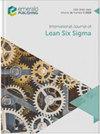在实际生产工厂中集成六西格玛和模拟以提高性能——案例分析
IF 3.7
2区 工程技术
Q2 ENGINEERING, INDUSTRIAL
引用次数: 1
摘要
目的本研究的总体目标是将精益六西格玛(LSS)框架与计算机模拟相结合,以提高发光二极管(LED)制造厂的生产效率。设计/方法论/方法论最近,将六西格玛和模拟模型的优势结合起来的想法促使行业和学术界进一步研究和实施这些方法论。从这个角度来看,本研究将通过结合系统动力学(SD)、离散事件仿真(DES)和基于代理的建模(AB)三种仿真方法,说明在真实工厂环境中使用LSS方法的有效性。发现本研究中应用的混合仿真方法可以准确地模拟和建模现有的真实工厂环境。基于定义、测量、分析、控制和改进(DMAIC)的改进表明,该方法能够在平衡工作量的同时提高机器利用率。此外,几个站点的队列长度缩短,平均处理时间减少了约50%。此外,每周产量增加了25%,同时单位成本降低了约8%。研究局限性/含义虽然所用的案例研究是针对LED制造系统的,但所提出的框架可以用于任何其他现有的生产系统。该研究还详细介绍了开发多方法模拟模型的步骤,使读者能够复制该模型,并为自己的案例研究和项目量身定制。混合模型使管理者能够在选择先进的生产产出而不是持续改进实践时,做出他们经常面临的权衡决策。采用本文中概述的方法将在队列长度、利用率、降低成本以及提高真实小型工厂的质量和效率方面实现改进。研究结果表明,从业者对质量工具的使用有所改进,并提高了他们的意识,这将为他们的公司带来直接利益。尽管多方法模拟是有效的,但当前研究的局限性在于缺乏每个站点内的微观细节。此外,这些结果都是基于一个具体的案例研究,不足以提出和概括研究结果。独创性/价值本研究将三种主要的混合模拟范式(SD、DES和AB)的使用结合在一个统一的框架DMAIC方法论中。在DMAIC中选择正确的模型是重要的、具有挑战性的和迫切需要的。此外,本文还展示了其有效性的实证证据。本文章由计算机程序翻译,如有差异,请以英文原文为准。
Integration of Six Sigma and simulations in real production factory to improve performance – a case study analysis
Purpose
The overarching objective of this research is to integrate the Lean Six Sigma (LSS) framework with computer simulation to improve the production efficiency of a light-emitting diode (LED) manufacturing factory.
Design/methodology/approach
Recently, the idea of taking advantage of the benefits of Six Sigma and simulation models together has led both industry and the academy towards further investigation and implementation of these methodologies. From this perspective, the present research will illustrate the effectiveness of using LSS methodology in a real factory environment by using the combination of three simulation methods which are system dynamics (SD), discrete-event simulation (DES) and agent-based (AB) modelling.
Findings
The hybrid simulation method applied in this research was found to accurately mimic and model the existing real factory environment. The define, measure, analyse, control and improve (DMAIC)-based improvements showed that the applied method is able to improve machine utilization rates while balancing the workload. Moreover, queue lengths for several stations were shortened, and the average processing time was decreased by around 50%. Also, a weekly production increase of 25% was achieved while lowering the cost per unit by around 8%.
Research limitations/implications
While the case study used was for a LED manufacturing system, the proposed framework could be implemented for any other existing production system. The research also meticulously presents the steps carried out for the development of the multi-method simulation model to allow readers to replicate the model and tailor it for their own case studies and projects. The hybrid model enables managers to navigate the trade-off decisions they often face when choosing advanced production output ahead of continuous improvement practices. The adoption of methodologies outlined in this paper would attain improvements in terms of queue lengths, utilization, reduced costs and improved quality and efficiency of a real, small factory. The findings suggest improvements and create awareness among practitioners for the utilization of quality tools that will provide direct benefits to their companies. Although the multi-method simulation is effective, a limitation of the current study is the lack of micro details within each station. Furthermore, the results are all based on one specific case study which is not enough to suggest and generalized findings.
Originality/value
This research combines the use of the three main hybrid simulation paradigms (SD, DES and AB) in a unified framework DMAIC methodology. Choosing the right models in DMAIC is important, challenging and urgently necessary. Also, this paper shows empirical evidence on its effectiveness.
求助全文
通过发布文献求助,成功后即可免费获取论文全文。
去求助
来源期刊

International Journal of Lean Six Sigma
Engineering-Industrial and Manufacturing Engineering
CiteScore
8.90
自引率
15.00%
发文量
46
期刊介绍:
Launched in 2010, International Journal of Lean Six Sigma publishes original, empirical and review papers, case studies and theoretical frameworks or models related to Lean and Six Sigma methodologies. High quality submissions are sought from academics, researchers, practitioners and leading management consultants from around the world. Research, case studies and examples can be cited from manufacturing, service and public sectors. This includes manufacturing, health, financial services, local government, education, professional services, IT Services, transport, etc.
 求助内容:
求助内容: 应助结果提醒方式:
应助结果提醒方式:


